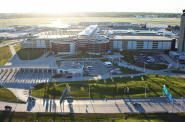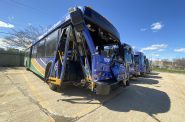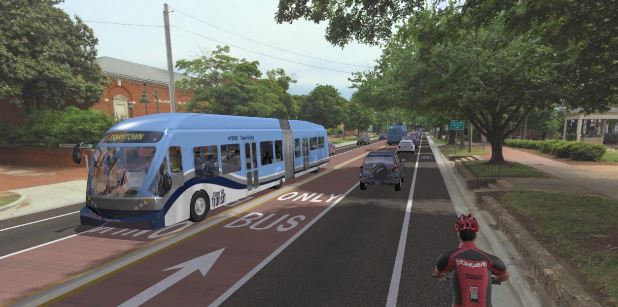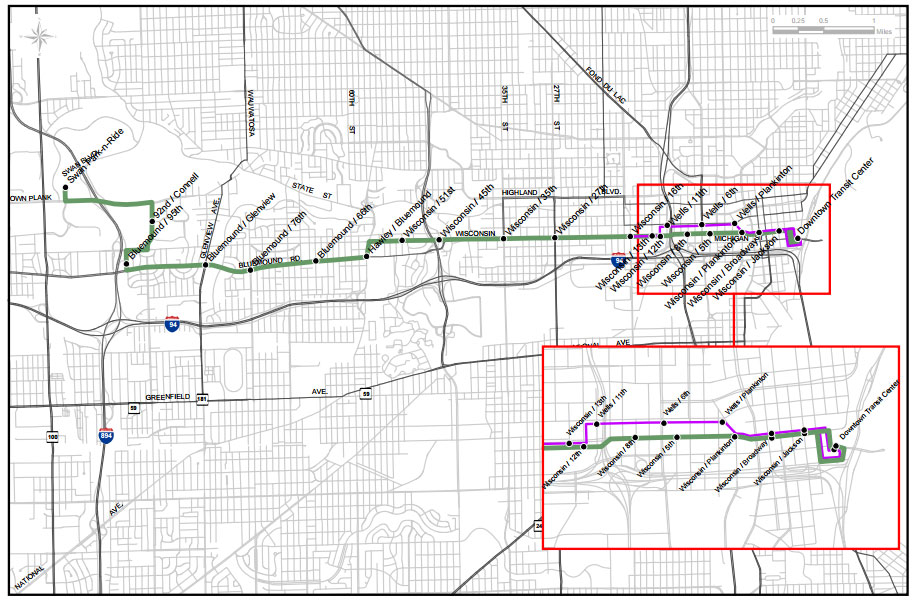City Approves Bus Rapid Transit
Nine-mile BRT project rolls forward, but not without strategic modifications.
The Milwaukee Common Council approved the framework for a bus rapid transit line to connect downtown Milwaukee with the city’s west side and Wauwatosa. County Executive Chris Abele, who has championed the project, now needs approval from the Milwaukee County Board of Supervisors to move forward with a federal grant for the million project, which has an estimated price tag of at least $42 million.
The roughly nine-mile, twelve-stop line would run from the site of the proposed The Couture tower on the lakefront and west on Wisconsin Ave. to Hawley Rd., and then along Bluemound Rd. before snaking through the Milwaukee Regional Medical Center to the park-and-ride at Swan Boulevard.
The city adopted the proposal on a 14-1 vote, with only alderman Mark Borkowski objecting, but not without modifying the proposal. Alderman Robert Bauman and Michael Murphy, whose districts the route would run through, have inserted two clauses into the resolution protecting parking spaces. Prior to the Public Works Committee‘s adoption of the project, Bauman had a clause inserted that bars the county from taking the parking for a dedicated travel lane east of N. 35th St. Murphy introduced a successful amendment today at the full council that expanded the parking protection to a stretch between N. 60th St. and N. Hawley Rd.
The project, which would be 80 percent federally funded, would cost between $42-to-$48 million depending on the number of dedicated lanes set aside for the system. Substantial ridership gains in the corridor, upwards of 30 percent, are estimated by the project’s consultants, AECOM and HNTB.
Gains in ridership are expected to come from high frequency of services (every 10 minutes on weekdays, every five minutes during rush hours), fewer stops and off-bus ticketing (both leading to reduced travel time), better stations than traditional bus shelters and improved vehicles that would cost upwards of $1 million each. The corridor, which consultant Dan Meyers called “the spine of the transit system” at the committee meeting, would have considerable benefit for its residents: 23 percent of those living within a half-mile of the route lack an automobile in their household, far above the county average, statistics show. Along the route are major employment and job centers including Downtown (81,000 jobs, 25,000 residents), Near West Side (40,000 residents, 30,000 jobs) and Milwaukee Regional Medical Center (16,000 jobs, 30,000 daily visitors).
Next Steps
If the county board approves the project at their Thursday meeting, a widely expected move, the county will apply on September 2nd for a Small Starts grant from the federal government. If not approved, because of federal application rules, the county would need to wait an additional year to apply. That would explain the rush to approve the plan.
The City of Wauwatosa previously granted their approval for the project on June 21st.
If the federal grant is awarded to the county, the county would begin doing engineering work on the project in 2017 with construction to begin in 2018. Service would begin in 2019.
The Wauwatosa and Milwaukee city councils will need to approve any future road closures, station locations and other infrastructure in their respective cities should the federal grant be awarded.
Is The Project Being Rushed?
In the hearing before the Public Works Committee on July 13, one comment was repeatedly echoed by aldermen Bauman and Murphy, that the project is being rushed. Murphy repeated those comments on the council floor when he introduced his amendment. The county, according to County Executive Chris Abele, is moving forward with the project as a way to compensate for the expected negative impacts of the rebuild of the roughly parallel Interstate 94.
During their final remarks on the matter at committee, Bauman stated “I have concerns not about the merits of bus rapid transit, but how this project has been rolled out in Milwaukee County. I think this is being rushed, I think this is being oversold.” Murphy admonished the process in the same fashion, stating “I do think it was rushed,” adding that the state has yet to allocate any funds to the Interstate 94 rebuild. At council, Murphy stated that he believes the rebuild wouldn’t happen until 2020 at the earliest.
The county might have another timeline in mind for the BRT, regardless of the timing of the Interstate 94 rebuild. While there hasn’t been much discussion about it, the county must compensate for the Congestion Mitigation and Air Quality grant expiring that helps support the operation of the Gold Line service in the same corridor. BRT could replace the Gold Line and gain different federal funding to replace that being lost.
Route Map
Past Coverage and Press Releases
- City Panel Approves Bus Rapid Transit – July 13th, 2016 – Jeramey Jannene
- PR: Milwaukee County BRT Project Receives Wide Ranging Support from Community Leaders, Advocates, Business Groups and Riders – July 11th, 2016 – Chris Abele
- Does Anyone Oppose Bus Rapid Transit – June 7th, 2016 – Bruce Murphy
- Milwaukee Bus Rapid Transit Line Will Attract Thousands of New Riders and Better Serve Low Income Riders – May 18th, 2016 – MCTS
- Bus Rapid Transit Meetings This Week – April 12th, 2016 – Jeramey Jannene
- PR: Bus Rapid Transit Public Meetings This Week – April 11th, 2016 – MCTS
- PR: New Website Highlights Bus Rapid Transit Study and Project – March 29th, 2016 – MCTS
- County Plans for Bus Rapid Transit – January 16th, 2016 – Matthew Wisla
- Transit Expansion Urged – June 25th, 2015 – Michael Horne
- PR: Milwaukee County to Lead Development of Bus Rapid Transit Service – June 2nd, 2015 Chris Abele
More about the East-West BRT Line
- Transportation: Off-Board Fare Collection Begins on Connect 1 - Graham Kilmer - Apr 16th, 2024
- Streetcar Begins Daily Service To The Couture, BRT Will Soon Follow - Jeramey Jannene - Apr 11th, 2024
- Transportation: Connect 1 Ridership Continues to Grow - Graham Kilmer - Nov 23rd, 2023
- Transportation: Battery Electric Buses Will Return This Fall - Graham Kilmer - Sep 8th, 2023
- Transportation: MCTS Pulling New Battery Electric Buses From the Road - Graham Kilmer - Aug 24th, 2023
- MKE County: Local Leaders Celebrate Launch of BRT Service - Graham Kilmer - Jun 5th, 2023
- Transportation: Milwaukee’s First Bus Rapid Transit Line Is Open for Business - Graham Kilmer - Jun 4th, 2023
- Transportation: New Bus Rapid Transit Line Launches Sunday, GoldLine Ends - Graham Kilmer - Jun 3rd, 2023
- Transportation: Federal Funds Creating Two New East-West BRT Stations - Graham Kilmer - May 19th, 2023
- Transportation: First 4 Months of BRT Rides Will be Free - Graham Kilmer - May 9th, 2023
Read more about East-West BRT Line here
Political Contributions Tracker
Displaying political contributions between people mentioned in this story. Learn more.
Eyes on Milwaukee
-
Church, Cupid Partner On Affordable Housing
 Dec 4th, 2023 by Jeramey Jannene
Dec 4th, 2023 by Jeramey Jannene
-
Downtown Building Sells For Nearly Twice Its Assessed Value
 Nov 12th, 2023 by Jeramey Jannene
Nov 12th, 2023 by Jeramey Jannene
-
Immigration Office Moving To 310W Building
 Oct 25th, 2023 by Jeramey Jannene
Oct 25th, 2023 by Jeramey Jannene
Transportation
-
Airport Traffic Soared Higher in 2024
 Feb 5th, 2025 by Graham Kilmer
Feb 5th, 2025 by Graham Kilmer
-
MCTS Driver Charged With Homicide for Hitting, Killing Pedestrian
 Feb 4th, 2025 by Graham Kilmer
Feb 4th, 2025 by Graham Kilmer
-
Trump Administration Slashes Popular Transportation Grant Program by 90%, Imperiling Milwaukee Funding
 Jan 31st, 2025 by Graham Kilmer
Jan 31st, 2025 by Graham Kilmer
























@ Jeramey N. 60th and N. Hawley are the same road. What were the stretches in Ald. Murphy’s amendment? From 35th to Hawley/60th?
@ Jeramey NEVERMIND
Could you clarify what the parking change means specifically? (Or maybe it’s still unclear.)
East of 35th Street, does this mean that every existing curbside parking space (or at least a like number) must remain after this project is implemented? And does “east of 35th Street” mean all the way from 35th to the lakefront? If so, this probably rules out dedicated lanes through downtown, at least between roughly 8th/9th streets and the river. Even if the route is shifted from Wisconsin to Wells on this portion, it’s hard to see how there would be dedicated transit lanes without removing at least some parking.